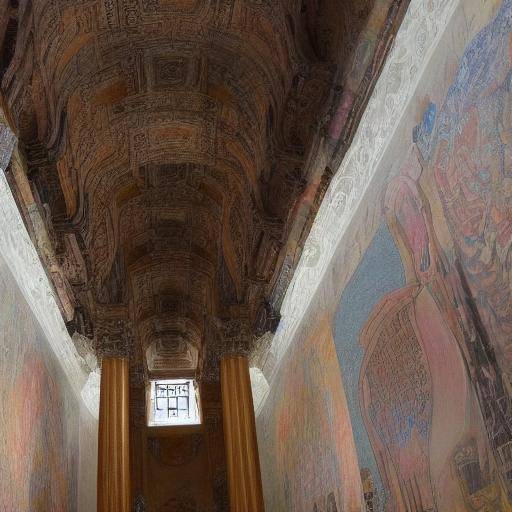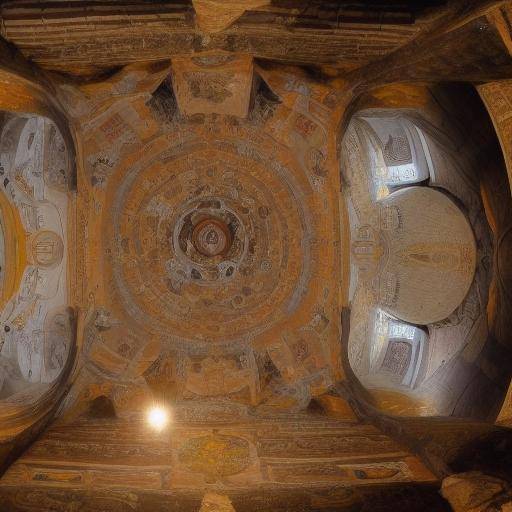
The Temple of Heaven, located in Beijing, China, is an emblematic site of great cultural and historical importance. This iconic temple, full of sculptures, paintings and an imperial architectural design, represents the rich heritage of Chinese art and its deep connection to spirituality. In this article, we will explore in detail the fascinating combination of visual arts and imperial architecture in the Temple of Heaven, as well as its relationship with the city of Beijing and Chinese art in general.
Introduction
The Temple of Heaven, known in Chinese as "Tiantan", is situated in the middle of a vast complex comprising the main circular temple, the circular altar, the imperial vault of the rain prayers and the walls of the palace. This site, which was used by the emperors of the Ming and Qing dynasties to offer sacrifices to Heaven and seek prosperity for the people, is an architectural masterpiece that reflects the world's worldview in ancient Chinese culture.
History and Background
The Temple of Heaven was built between 1406 and 1420 during the reign of Emperor Yongle of the Ming dynasty. Over the centuries, he has witnessed significant historical changes, from the fall of the monarchy to his recognition as UNESCO World Heritage in 1998.
The architectural design of the Temple of Heaven is an impressive manifestation of the technical and aesthetic sophistication of the Chinese engineering of the time. Geometric precision, symmetry and meticulous care in the selection of materials reflect the profound observance of the principles of harmony and balance in Chinese cosmology.
Analysis in Deep
The art present in the Temple of Heaven is a magnificent synthesis of sculptures, paintings and reliefs, all of them intricately intertwined with the imperial architecture. The sculptures of dragons, phoenix and other mythical creatures adorn the ceilings and walls, infusing each space with a heavenly energy and a deep cultural symbolism.
The paintings in the Temple of Heaven are an impressive display of artistic and historical narrative skills. The frescoes that represent landscapes, deities and ritual scenes capture the spiritual and emotional wealth of imperial worship, providing a unique window to the mentality of ancient China.
Comprehensive review
The Temple of Heaven is not only a historical monument, but also a deposit of knowledge about the technology, astronomy and culture of the time. Construction methods, astronomical calendars and associated ritual ceremonies testify to the depth of knowledge accumulated by past generations.
Comparative analysis
Compared to other architectural sites in Beijing, the Temple of Heaven stands out for its focus on spiritual connection with the universe and the desire for cosmic harmony. The Forbidden City, on the other hand, represents political power and imperial authority, while the Great Wall China symbolizes the protection and defense of the country.
Practical Tips and Accessible Tips
To fully appreciate the art and architecture of the Temple of Heaven, it is recommended to explore the place during different moments of the day to capture the essence of its beauty in morning, day and evening light. In addition, knowing the history and symbolism behind each artistic and architectural element enhances the visit experience.
Conclusions and FAQs
The Temple of Heaven is a lasting testimony of art, culture and spirituality in Chinese history. This architectural gem continues to captivate visitors from around the world and serves as an eloquent reminder of China's deep cultural legacy.
To further explore the artistic and architectural richness of the Temple of Heaven, as well as to better understand its relationship with Chinese art in general, we will consider a few key questions:
Question 1: What is the importance of the Temple of Heaven in Chinese Culture?
The Temple of Heaven is of utmost importance in Chinese culture, as it represents the connection between the emperor and Heaven, symbolizing divine authority and ontological harmony. This architectural structure reflects the Chinese cosmovision and spirituality, making it a lasting symbol of the country's rich history and culture.
Question 2: What artistic elements stand out in the Temple of Heaven?
The Temple of Heaven presents an exquisite combination of sculptures, paintings and reliefs with heavenly motifs, dragons, phoenix and landscapes, all of them integrated into the imperial architectural design. These works of art are not only aesthetically impressive, but also convey deep Chinese beliefs and cultural values.
Question 3: How does the art of the Temple of Heaven relate to Chinese art in general?
The art of the Temple of Heaven reflects the traditional styles, themes and artistic techniques of China. From the meticulous craftsmanship of sculptures to the symbolic narrative of paintings, the art of the Temple of Heaven represents a microcosm of the diversity and depth of Chinese art, serving as an emblem of the country's cultural identity.
Question 4: What influence has the Temple of Heaven had in Chinese imperial architecture?
The Temple of Heaven has exerted a significant influence on Chinese imperial architecture, serving as a model for numerous sacred buildings and palaces throughout history. Its symmetrical design, use of select materials and careful layout of architectural elements have left an indelible mark on the evolution of Chinese imperial architecture.
Question 5: How is the art of the Temple of Heaven preserved and protected?
The art of the Temple of Heaven is preserved through rigorous conservation and maintenance measures. The Chinese authorities implement restoration and protection programs to ensure the continuous integrity and splendour of the temple's sculptures, paintings and architectural designs, thus ensuring its legacy for future generations.
Question 6: What is the impact of the Temple of Heaven on contemporary tourism and culture?
The Temple of Heaven is an important tourist destination, attracting both local and international visitors with its rich history, artistic beauty and spiritual aura. In addition, its cultural heritage contributes to enriching the public understanding of Chinese history and culture, playing a vital role in promoting the cultural heritage of the country.
In conclusion, the Temple of Heaven is a treasure of Chinese imperial art that embodies the beauty, spirituality and wisdom of an ancient civilization. By exploring this sublime site, visitors have the opportunity to immerse themselves in China's rich cultural heritage and appreciate the artistic and architectural mastery that has endured over the centuries.

